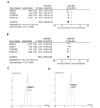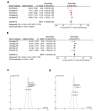Gender and outcomes in non-small cell lung cancer: an old prognostic variable comes back for targeted therapy and immunotherapy?
- PMID: 29682332
- PMCID: PMC5905840
- DOI: 10.1136/esmoopen-2018-000344
Gender and outcomes in non-small cell lung cancer: an old prognostic variable comes back for targeted therapy and immunotherapy?
Abstract
Background: There are well-known differences in gender outcome in non-small cell lung cancer (NSCLC) and other cancers. In this work, we evaluated several randomised clinical trials to explore the gender influence in the outcome of patients with NSCLC treated with targeted therapy and immunotherapy.
Methods: We performed a series of meta-analysis to compare the gender outcome in the routine setting for overall survival and progression-free survival (PFS) in phase III randomised clinical trials comparing EGFR inhibitors versus chemotherapy (OPTIMAL, LUX-lung 3, LUX-lung 6, EURTAC, ENSURE and WTJOG); ALK inhibitors versus chemotherapy (ASCEND 4, ASCEND 5, PROFILE 1014 and NCT009323893) and anti-PD1 checkpoint inhibitors versus chemotherapy (CheckMate 017, CheckMate 026, CheckMate 057, KEYNOTE 010 and KEYNOTE 024).
Results: Female patients with NSCLC have a reduced risk of death compared with men (HR=0.73; 95% CI 0.67 to 0.79; p<0.00001). Women had a better benefit from EGFR inhibitors than men (HR=0.34; 95% CI 0.28 to 0.40; p<0.00001 vs HR=0.44; 95% CI 0.34 to 0.56; p<0.00001, respectively). The benefit from ALK inhibitors was similar for both genders (HR=0.51; 95% CI 0.42 to 0.61; p<0.00001 vs HR=0.48; 95% CI 0.39 to 0.59; p<0.00001, for women and men, respectively). Anti-PD1 inhibitors significantly improved the PFS in male patients when compared with chemotherapy (HR=0.76; 95% CI 0.68 to 0.86; p<0.00001); in contrast, women showed no benefit in 5/5 randomised trials (HR=1.03; 95% CI 0.89 to 1.20; p=0.69).
Conclusions: In this exploratory study, some targeted treatments were influenced by gender. Despite differences in outcomes that could be attributed to different histology, EGFR and smoking status, gender should be evaluated more deeply as prognostic variable in patients with NSCLC.
Keywords: gender; non-small cell lung cancer; prognostic factors; targeted therapy.
Conflict of interest statement
Competing interests: None declared.
Figures




References
-
- Ferlay J, Soerjomataram I, Ervik M, et al. . Cancer incidence and mortality worldwide: IARC CancerBase No. 11. Lyon, France: International Agency for Research on Cancer, 2013. (accessed 8 Aug 2017).
-
- Risch HA, Howe GR, Jain M, et al. . Are female smokers at higher risk for lung cancer than male smokers? A case-control analysis by histologic type. Am J Epidemiol 1993;138:281–93. - PubMed
LinkOut - more resources
Full Text Sources
Other Literature Sources
Research Materials
Miscellaneous

